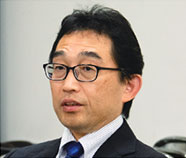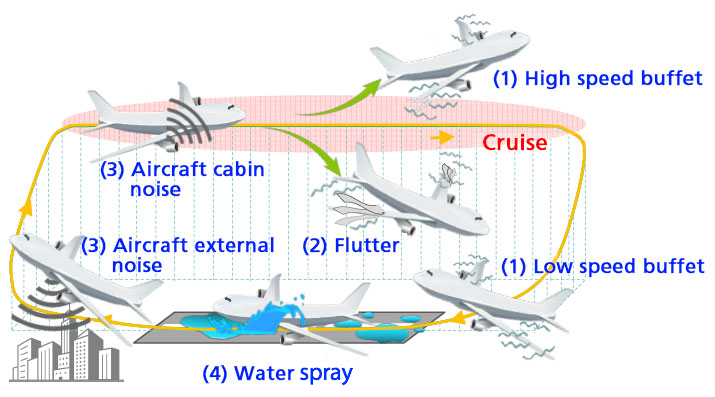About us
JAXA Aviation helps to create a safer and more prosperous society with aeronautics-related research and development activities.
FLIGHT PATH No.22 | 2018 WINTER
JAXA's Aspirations behind the Fourth Mid-to-long-term Plan
Reflecting on ideas discussed by the strategic working group
Strengthening basic and fundamental technology research Using integrated simulation technologies to solve complicated multidisciplinary problems

AIOYAMA Takashi
Director of the Numerical Simulation Research Unit
The Fourth Mid-to-long-term Plan places an emphasis on strengthening basic and fundamental technology research.
Basic and fundamental technologies are hard to see from the outside. As such, I propose to bring together various fundamental research activities being conducted at JAXA and visualize them as a “hub,” or a “platform.” This eventually led us to start studying “integrated simulation technologies.”
This concept integrates a wide range of simulation technologies in a multidisciplinary fashion, centering on computer-based numerical simulation technology and including ground test technologies (such as wind tunnels, engine test facilities and structural test facilities) and flight test technologies. It is an approach that aims to solve complicated multidisciplinary problems in order to improve aircraft performance.
In wind tunnel tests, we have newly established measurement technologies such as pressure-sensitive paint (PSP) and particle image velocimetry (PIV), which uses microscopic oil particles to measure flow velocity. As for flight tests, we have accumulated flight data using our jet flying test bed “Hisho” and other experimental aircraft. Above all, advances in computer technology and the use of JAXA's high-speed fluid analysis tool called “FaSTAR” have increased the speed and accuracy of computational fluid dynamics (CFD) calculations.
As these technologies have matured, we thought the environment was finally ready for establishing integrated simulation technologies.
If we were to liken aircraft development to house building, fundamental technology would be comparable to tools like hammers and planers used to build a house. Therefore, strengthening fundamental technology is like replacing a hammer with a nail gun. By making full use of improved, more powerful tools, we should be able to increase development speed and accuracy dramatically.
What kind of integration do you aim to achieve through integrated simulation technologies?
What we have in mind is two types of integration. One is to leverage scientific methods like numerical simulation, ground and flight tests, and data science in an integrated manner toward a common goal. The other is to integrate and utilize knowledge in various disciplines, including aerodynamics, structures, acoustics, and multiphase flow, in order to solve complex problems that cut across multiple fields. To this end, creating synergy through cooperation among researchers with diverse expertise is essential.
As the first step in this effort, we are currently building a multidisciplinary integrated simulation system called the Integrated Simulation System of Aerospace vehiCles (ISSAC), which covers the full flight envelope including off-design flight conditions other than cruising conditions. Specifically, we are aiming to develop technology that can predict unsteady aerodynamic phenomena such as high and low speed buffet, flutter, aircraft cabin and external noise, and water spray on a wet runway.
The simulation tools we will develop and our know-how on testing technology will be incorporated into a cyber simulator and a physical simulator, respectively. The calculation results obtained by the simulation tools on a supercomputer and test results will be stored on an integrated database. These will all be connected over a network, and users will be able to access them anytime through a portal server on the network.

Technological challenges to be tackled in the ISSAC
(1) Prediction of low and high speed buffet (airframe vibration), (2) prediction of flutter (aerodynamic/structural coupled vibration), (3) prediction of aircraft cabin/external noise, and (4) prediction of water spray on a wet runway
What is the roadmap for Aeronautical Science and Basic and Technology Research?
Up to now, research and development have been conducted within the confines of each discipline, but in the Fourth Mid-to-long-term Plan we will integrate airframe technologies, excluding engine technologies, into the infrastructure system of the ISSAC. Then in the Fifth Mid-to-long-term Plan, we will move on to the next stage and extend the ISSAC by integrating the airframe technologies with the engine technologies. We will take this even further in the Sixth Mid-to-long-term Plan and apply simulation technologies to situations where multiple aircraft are flying, which basically means expanding the scope of application to actual flight operations.
The ISSAC is primarily an activity to improve high-value research results generated by JAXA and implement them in society. In our work, we are also actively pursuing creative research that could provide seeds for social implementation in the next generation.
JAXA's Aspirations behind the Fourth Mid-to-long-term Plan
Reflecting on ideas discussed by the strategic working group
- Toward broader social implementation, stronger fundamental research base, and creation of new value that provides innovative solutions to existing issues
- Accelerating core engine technology research
- Using integrated simulation technologies to solve complicated multidisciplinary problems
- Building on past research to make silent supersonic passenger aircraft a reality